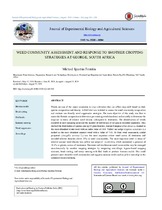| dc.contributor.author | Ferreira, Michael Ignatius | |
| dc.date.accessioned | 2020-12-10T09:37:22Z | |
| dc.date.available | 2020-12-10T09:37:22Z | |
| dc.date.issued | 2020 | |
| dc.identifier.citation | Ferreira, M. I. (2020). Weed community assessment and response to smother cropping strategies at George, South Africa. Journal of experimental biology and agricultural sciences,8(4), 369-380 | en_US |
| dc.identifier.issn | 2320-8694 | |
| dc.identifier.uri | http://dx.doi.org/10.18006/2020.8(4).369.380 | |
| dc.identifier.uri | http://hdl.handle.net/10566/5490 | |
| dc.description.abstract | Weeds are one of the major constraints to crop cultivation that can affect crop yield based on their
species composition and density. A field trial was initiated to assess the weed community composition
and evaluate eco-friendly weed suppressive strategies. The main objective of this study was first to
assess the floristic composition to determine pre-existing weed abundance and secondly to determine the
response in terms of relative weed density subsequent to treatments. The identification of weeds
occurred at each sampling point and the number of individuals of all species recorded separately. This
showed the distribution of species among 19 plant families. Annual bluegrass (Poa annua L.) ranked as
the most abundant winter weed with an index value of 34.9. Yellow nut sedge (Cyperus esculentus L.)
ranked as the most abundant summer weed with a value of 74.8. | en_US |
| dc.language.iso | en | en_US |
| dc.publisher | Editorial board of Journal of Experimental Biology and Agricultural Sciences | en_US |
| dc.subject | Biomass mulch | en_US |
| dc.subject | Brush cutting | en_US |
| dc.subject | Flail heads | en_US |
| dc.subject | Rotarary mowing | en_US |
| dc.subject | Weed suppression | en_US |
| dc.title | Weed community assessment and response to smother cropping strategies at George, South Africa | en_US |
| dc.type | Article | en_US |

